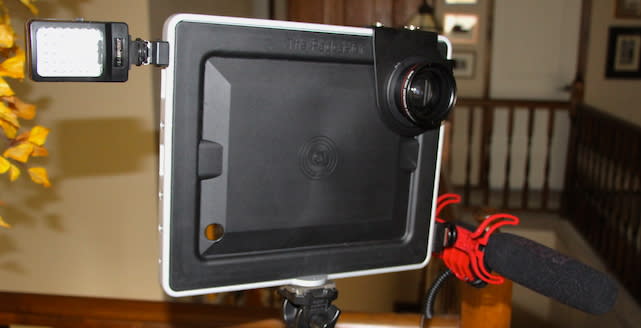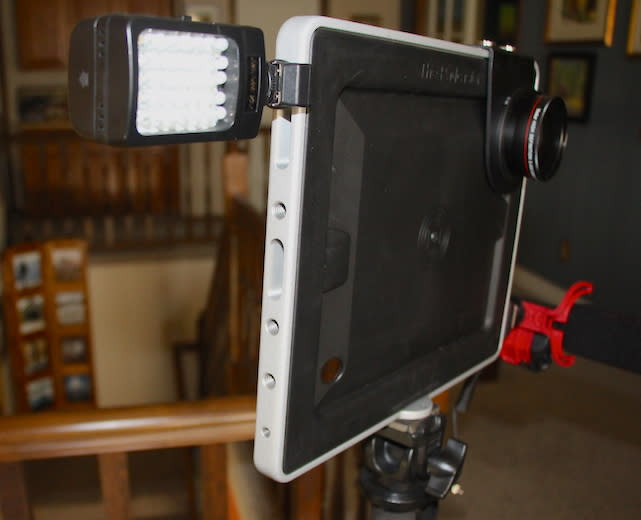TUAW takes a second look at The Padcaster

Way back in 2012, I reviewed a pre-production version of The Padcaster, an amazing pro tool that's used to equip an iPad with all sorts of accessories for professional-quality video or photography. You probably remember seeing a Padcaster in one of Apple's "What will your verse be?" advertisements, being used to shoot video of Iguazú Falls in Argentina. The person in that segment of the ad was Josh Apter, the brain behind the Padcaster and the president and founder of Manhattan Edit Workshop.
The Padcaster is now in full production and available for the iPad Air (US$159), iPad mini ($99), and 2nd through 4th generation iPads ($149), so I decided to take another look at this versatile filmmaking and photography accessory.
Design Highlights
The Padcaster was obviously designed by a filmmaker who saw the potential of using the iPad for capturing video or stills. As such, it consists of a very solid aluminum frame with a flexible silicone insert that holds the iPad in place. The Padcaster we had for the original review was marked up with measurements and looked obviously like a prototype, with random holes drilled in places that seemed convenient. Not so with the final version, which is sleek, well-made and quite sturdy.
Around the outside of the Padcaster for iPad are at least fifteen 1/4-inch threaded holes, along with nine smaller threaded holes. If you can't get all of your equipment loaded onto a Padcaster, then you may need to rethink your filming strategy.

The Padcaster also comes with the Lenscaster, a precise threaded lens mount (58 mm) that is positioned over the camera on your iPad. For testing purposes, Josh thoughtfully provided a Vivitar .43X wide-angle lens to mount on the Lenscaster. A quick look at Amazon showed that 58mm threaded lenses from Vivitar are inexpensive -- the wide-angle lens runs $11.95, while a 2.2X telephoto lens is available for $11. Even a fisheye lens can be had for wild effects -- $40.

So, now you have your camera (the iPad), an editing suite (iMovie or one of the other video apps like Vizzywig), and a way to make titles (IntroMate). Add a sturdy tripod or monopod (I used my trusty Manfrotto monopod with quick-release mount), some of those inexpensive lenses and some add-on filters, lights and a good directional microphone, and you're ready to go.
What's more, rather than looking like a total fool waving your naked iPad around trying to take video, The Padcaster and accessories really make you look like a pro -- even if you're not. Appearances are everything, so having this piece of equipment with you might open doors that are closed to amateurs.
Functionality Highlights
One thing that can easily drive me nuts is having equipment that takes forever to set up. That's fortunately not the case with the Padcaster. I plopped an iPad into the frame, screwed on the Lenscaster and the wide-angle lens, added an external LED light and a Røde directional mic, and put the entire assembly onto the Manfrotto monopod in about five minutes.
All of the threaded holes were flawless with no binding, and there are cutouts in all the right places on The Padcaster in case you need access to an iPad port. When you purchase a Padcaster, you are actually getting a full kit that includes the Padcaster, Lenscaster, 72mm-58mm step-down ring (the adapter for those screw mount lenses), two 1/4-20 screws, two 3/8-16 screws, one custom camera mount screw and one cold shoe adapter. That's a surprising amount of good stuff for such a reasonable price.
If you already purchased a Padcaster for the 2nd- through 4th-generation iPad and want to use a new iPad Air with it, no problem -- there's a $24.95 Padcaster Air clip available that works not only to mount the iPad Air in the "old" Padcaster, but also works with an included handstrap for handheld use of the iPad Air.
So who is The Padcaster for? Basically anyone who wants to make a quantum leap in their iPad photography or videography by adding lenses, filters, professional microphones and audio equipment, lights, and more. Professionals who are considering using an iPad for shooting need a Padcaster, no questions asked. Advanced amateurs may just find that adding all of those accessories to their iPad bumps up their work to professional level.
Conclusion
I was glad that I had a chance to look at The Padcaster again, so that I could see what a production version of the device looks like, how it fit the iPad, and how the entire accessory kit comes together. Josh Apter did the iPad videography community a huge favor by inventing this device, and I look forward to watching The Padcaster evolve. I personally plan on getting the iPad mini version for doing both TUAW work and personal videography.
Rating: 4 stars out of 4 stars possible


